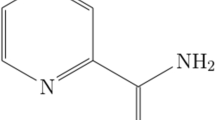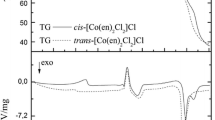Abstract
In the present work for the first time, the temperature dependence of the heat capacity \(C_{\text{p}}^{\text{o}}\) = f(T) of tetraphenylantimony (1-adamantanecarboxylate) was determined in the range 5.6–456 K by methods adiabatic vacuum calorimetry and differential scanning calorimetry. The compound fuses in the range 414–446 K without decomposition, and thermodynamic characteristics of fusion were defined and analyzed. Multifractal treatment of low-temperature heat capacity was made as a result topological structure of the compound was established. The complex of standard thermodynamic functions (enthalpy, entropy, the Gibbs energy) was given for crystal and liquid states in the range from T → 0 to 456 K. Also, standard entropy of formation of a substance in the crystalline state at T = 298.15 K was calculated. Comparison of thermodynamic properties was made for the derivatives of antimony studied in the present work and earlier.


Similar content being viewed by others

References
Katerina T, Petra S. Synthesis and study of mixed oxide inorganic pigment from Bi2O3–ZnO–CeO2 system. J Therm Anal Calorim. 2017;130:57–62.
Rai US, Singh Manjeet, Rai RN. Some physicochemical studies on organic eutectics and intermolecular compounds. J Therm Anal Calorim. 2017;130:967–74.
Gielen M, Tiekink ERT. Metallotherapeutic drug and metal-based diagnostic agents. Hoboken: Wiley; 2005.
Pellerito L, Nagy L. Organotin(IV)n+ complexes formed with biologically active ligands: equilibrium and structural studies, and some biological aspects. Coord Chem. 2002;224:111.
Takahashi S, Sato H, Kubota Y, Utsumi H, Bedford JS, Okayasu R. Inhibition of DNA-double strand break repair by antimony compounds. Toxicology. 2002;180:249.
Wang G-C, Yong-Na L, Xiao J, Lin Y, Song H-B, Li J-S, Cui J-R, Wang R-Q, Ran F-X. Synthesis, crystal structures and in vitro antitumor activities of some organoantimony arylhydroxamates. J Organomet Chem. 2005;690:151–6.
Sharutin VV, Sharutina OK, Pakusina AP, Platonova TP, Smirnova SV, Pushilin MA, Gerasimenko AV. Structural features of triorganylantimony dicarboxylates R3Sb[OC(O)R′)]2. Rus J Coordination Chem. 2003;29:780–9.
Ma C, Zhang Q, Sun J, Zhang R. Syntheses, characterizations and crystal structures of new organoantimony(V) complexes with heterocyclic (S, N) ligand. J Organomet Chem. 2006;691:2567–74.
Ivanov MA, Antzutkin ON, Sharutin VV, Ivanov AI, Pakusina AP, Pushilin MA, Forsling W. Preparation and structural organisation of heteroleptic tetraphenylantimony(V) complexes comprising unidentately and bidentately coordinated O, O′-dialkyldithiophosphate groups: multinuclear (13C, 31P) CP/MAS NMR and single-crystal X-ray diffraction studies. Inorg Chim Acta. 2007;360:2897–904.
Sharutin VV, Sharutina OK. Bis(tetraphenylantimony) succinate, malate, and tartrate: syntheses and structures. Rus J Coord Chem. 2014;40:643–7.
Gupta A, Sharma RK, Bohra R, Jain VK, Drake JE, Hursthouse MB, Light ME. Synthetic, spectroscopic and structural aspects of triphenylantimony(V) complexes with internally functionalized oximes: crystal and molecular structure of[Ph3Sb{ON=C(Me)C5H4 N-2}2]. Polyhedron. 2002;21:2387–92.
Sharutin VV, Molokova OV, Sharutina OK, Gerasimenko AV, Pushilin MA. Synthesis and structure of triarylantimony dioximates. Rus J Gen Chem. 2004;74:1485–91.
Sharutin VV, Senchurin VS, Fastovets OA, Pakusina AP, Sharutina OK. Tetraphenylantimony perrhenate and tetraphenylantimony chlorate: syntheses and structures. Rus J Inorg Chem. 2009;54:389–95.
Dodonov VA, Gushchin AV, Gor´kaev DA, Fukin GK, Starostina TI, Kurskii LN, Shavyrin AS. Synthesis and structures of triphenylantimony oximates. Russ Chem Bull. 2002;51:1051–7.
Luan SR, Zhu YH, Jia YQ, Cao Q. Characterization and thermal analysis of thiourea and bithmuth trichloride complex. J Therm Anal Cal. 2010;99:523–30.
Fomin VM, Markin AV. Oxidation mechanism of ferrocene with molecular oxygen. Kinetic and thermodynamic aspects. J Therm Anal Cal. 2008;92:985–7.
Ribeiro da Silva MAV, Santos AFLOM. Energetics of some sulphur heterocycles. Thiophene derivatives. J Therm Anal Cal. 2009;95:333–44.
Smirnova NN, Letyanina IA, Larina VN, Markin AV, Sharutin VV, Senchurin VS. Thermodynamic properties of pentaphenylantimony Ph5Sb over the range from T → 0 K to 400 K. J Chem Thermodyn. 2009;41:46–50.
Letyanina IA, Markin AV, Smirnova NN, Sologubov SS, Sharutin VV. Heat Capacity and Standard Thermodynamic Functions of Triphenylantimony Bis(1-adamantanecarboxylate) over the Range from (0 to 520) K. J Chem Eng Data. 2013;58:3087.
Markin AV, Letyanina IA, Ruchenin VA, Smirnova NN, Gushchin AV, Shashkin DV. Heat capacity and standard thermodynamic functions of triphenylantimony dimethacrylate over the temperature range from (0 to 400) K. J Chem Eng Data. 2011;56:3657.
Markin AV, Smirnova NN, Lyakaev DV, Klimova MN, Sharutin VV, Sharutina OK. Thermodynamics of dibenzoate triphenilantimony. Rus J Phys Chem. 2016;90:1–8.
Markin AV, Smirnova NN, Lyakaev DV, Sharutin VV, Sharutina OK. Thermodynamic properties of triphenylantimony dipropionate Ph3Sb(OC(O)C2H5)2 over the range from T → 0 to 430 K. J Chem Thermodyn. 2017;106:303–8.
Letyanina IA, Markin AV, Smirnova NN, Klimova MN, Kalistratova OV, Gushchin AV. Calorimetric study of organic compounds of antimony and bismuth Ph3Sb(O2CCH=CHCH3)2 and Ph3Bi(O2CCH=CHCH3)2. J Therm Anal Calorim. 2016;125:339–49.
Sharutin VV, Senchurin VS, Sharutina OK, Pakusina AP, Smirnova SA. Synthesis and Structure of Tetraphenylantimony 1-Adamantanecarboxylate and Triphenylantimony bis(1-adamantanecarboxylate). Rus J Inorg Chem. 2009;54:389–95.
Varushchenko RM, Druzhinina AI, Sorkin EL. Low-temperature heat capacity of 1-bromoperfluorooctane. J Chem Thermodyn. 1997;29:623–7.
Malyshev VM, Milner GA, Sorkin EL, Shibakin VF. Automatic low-temperature calorimeter. Prib Tekh Eksp. 1985;6:195–7.
Höhne GWH, Hemminger WF, Flammersheim H-J. Differential scanning calorimetry. 2nd ed. Heidelberg: Springer; 2003.
Drebushchak VA. Calibration coefficient of heat-flow DSC. Part II. Optimal calibration procedure. J Therm Anal Cal. 2005;79:213–8.
Meija J, Coplen TB, Berglund M, Brand WA, De Bievre P, Groning M, Holden NE, Irrgeher J, Loss RD, Walczyk T, Prohaska T. Atomic weights of the elements 2013. Pure Appl Chem. 2016;88:265–91.
Lazarev VB, Izotov AD, Gavrichev KS, Shebershneva OV. Fractal model of heat capacity for substances with diamond-like structures. Thermochim Acta. 1995;269–70:109–16.
Tarasov VV. Theory of heat capacity of chain and layer structures. Zh Fiz Khim. 1950;24:111–28.
Rabinovich IB, Nistratov VP, Telnoy VI, Sheiman MS. Thermochemical and thermodynamic properties of organometallic compounds. New York: Begell House Inc., Publishers; 1999.
Cox JD, Wagman DD, Medvedev VA. Codata key values for thermodynamics. New York; 1984 (database http://webbook.nist.gov/chemistry/).
DeSorbo W. The low temperature specific heat of antimony. Acta Metall. 1953;1:503–7.
Acknowledgements
This work was financially supported by the Ministry of Education and Science of The Russian Federation (Organization of Scientific Research, No. 4.6138.2017/6.7).
Author information
Authors and Affiliations
Corresponding author
Electronic supplementary material
Below is the link to the electronic supplementary material.
Rights and permissions
About this article
Cite this article
Lyakaev, D.V., Markin, A.V., Smirnova, N.N. et al. Thermodynamic properties of tetraphenylantimony 1-adamantanecarboxylate. J Therm Anal Calorim 133, 1143–1148 (2018). https://doi.org/10.1007/s10973-017-6803-5
Received:
Accepted:
Published:
Issue Date:
DOI: https://doi.org/10.1007/s10973-017-6803-5



